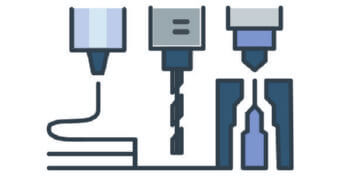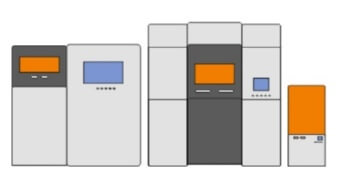A CNC router is a type of computer controlled machine created for milling, drilling and cutting materials. CNC routers are similar to milling machines, with some of them capable of performing almost the same tasks. The main functions are to cut, engrave and carve objects out of a work piece, essentially a replacement for the usual hand-held router. By introducing computer control to the process, the number of errors is drastically reduced.
How does a CNC router work?
CNC routers vary in their build volume and configuration; they can have one or more axis to work with and the ability to swap tools to perform different tasks. The key feature of these machines is the computer control, which moves, rotates and spins tools according to a CAM program, which can be created manually for relatively easy tasks or automatically using software. The software transforms a digital CAD file into a set of instructions for the machine to complete.
Why use a CNC router?
Routing is a common production method used in woodwork, signage, moldings, thermoforming, and more. It’s most effective when a precise cut is required on a regular basis. CNC routers, depending on their components, are compatible with various hard materials including wood, metal, stone, plastics, foam, acrylics, and glass. Some machines are equipped with dust collection systems, which soak in material chips and other waste during the process.
Computer controlled routers help to reduce production time and the frequency of manufacturing errors by creating near-identical objects each and every time, provided all external factors are controlled. CNC routers require technical assistance from time to time, with working tools and mechanisms wearing down over time. However, the production capabilities and speeds still make using these machines extremely cost-efficient for businesses and hobbyists.
Older versions of CNC routers used to be large and take up a lot of room but now modern machines come in various sizes, and there are even desktop versions, which fit on a table and still delivery superb results. Software used in routers has also improved, so even hobbyists are now able to operate simple machines with the help of CAD/CAM programs. Several programs are designed for special purposes and can help to create simple models, as well as generating codes for designs. This makes CNC routers helpful for tinkerers, furniture manufacturers and even designers, without the need for professional carving and woodworking skills.
Spindle or Router: which one to choose?
On the market, there are spindle and router-based CNC cutting machines available, and when it comes to choosing between the two, it’s crucial to understand their key differences. Spindles and routers are quite similar - they can cut a wide range of materials; but if hard materials are involved, spindles are definitely the better option.
Compared to routers, spindle machines typically have better bearings and are more powerful. This makes them a more precise and longer-lasting machine. On the flip side, spindle-based CNC machines are usually more expensive compared to routers.
CNC routers are used for quick intermittent cuts on high speeds. A router is the best choice for wood thanks to being able to reach high speeds quickly, but if trying to cut aluminum with a router, the results are likely to be worse. The lowest speeds on routers are usually too high for cutting aluminum, which leads a tool to deteriorate fast and provide a poor surface quality.
If comparing performance with wooden materials, both routers and spindles cut them accurately, but the price tags for DIY router kits are much lower. So, routers are the best choice when a CNC cutter won’t run all day long, when working with aluminum and when the noise won’t cause any problems.






